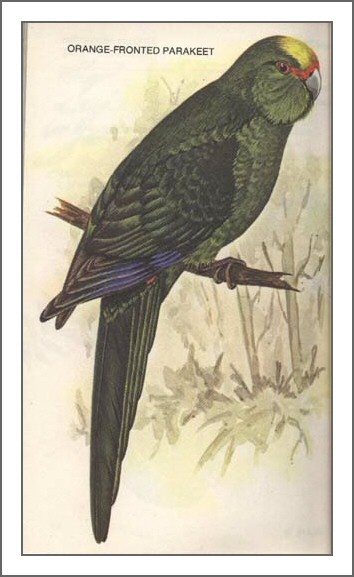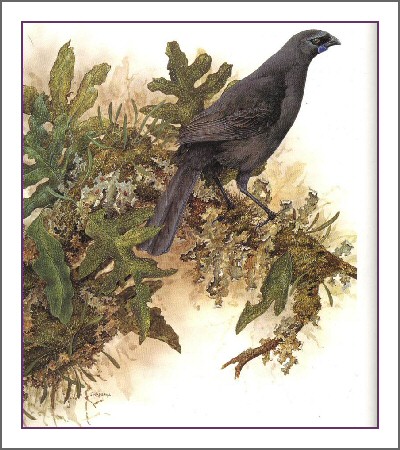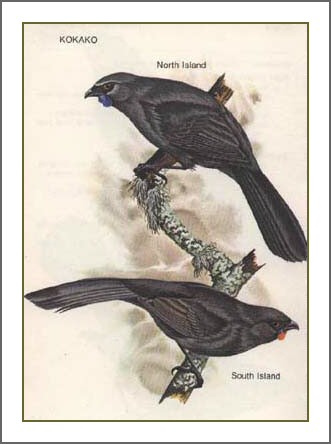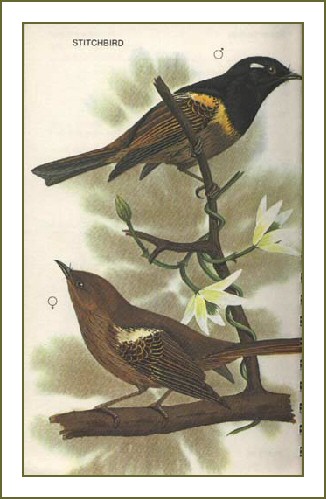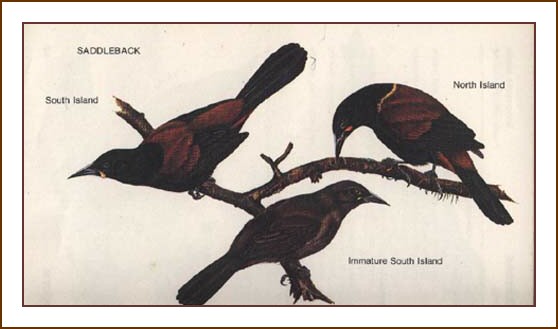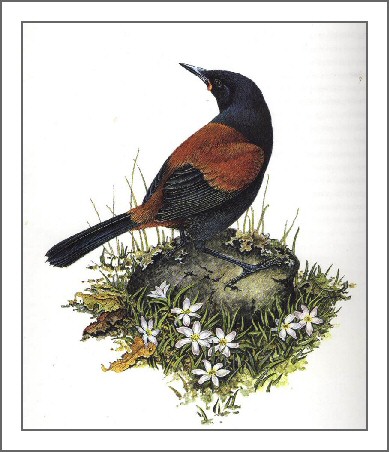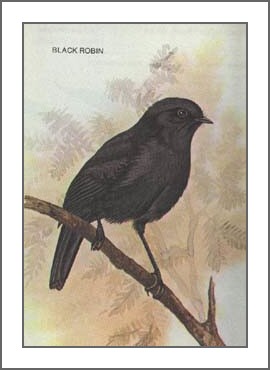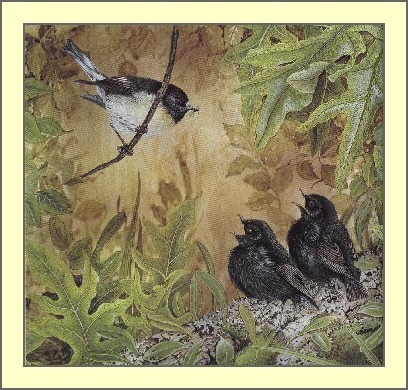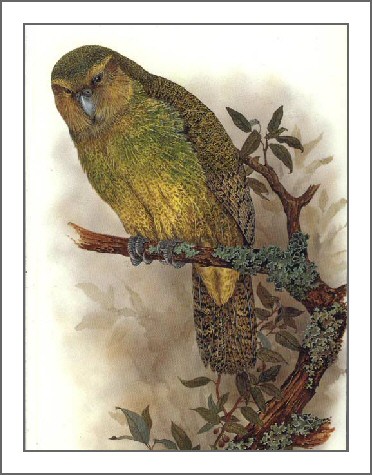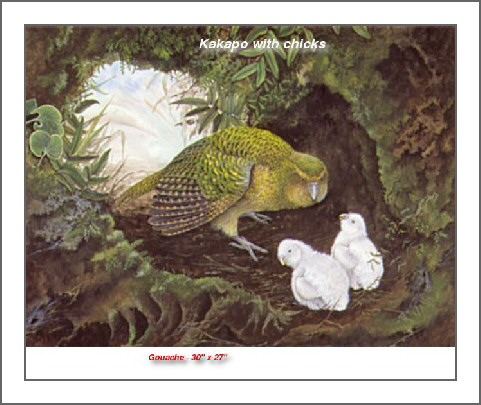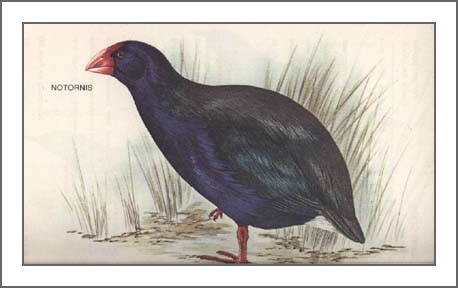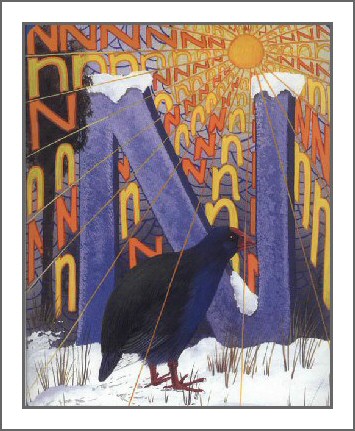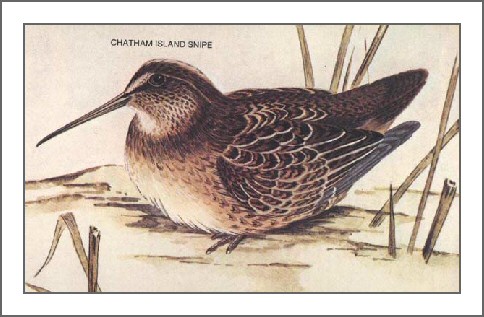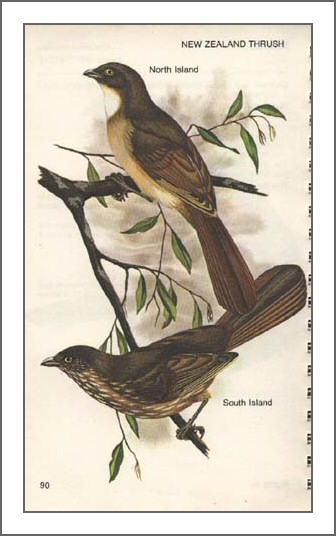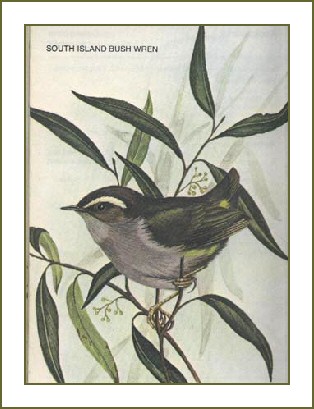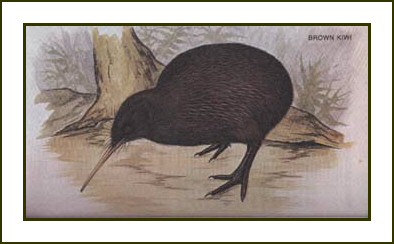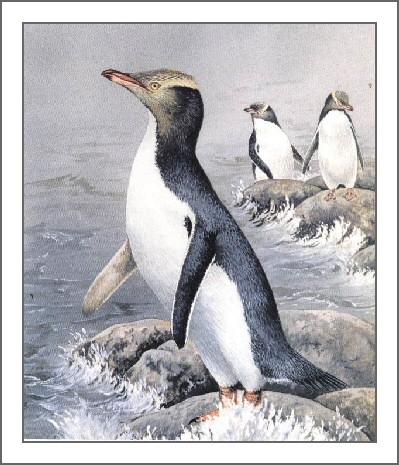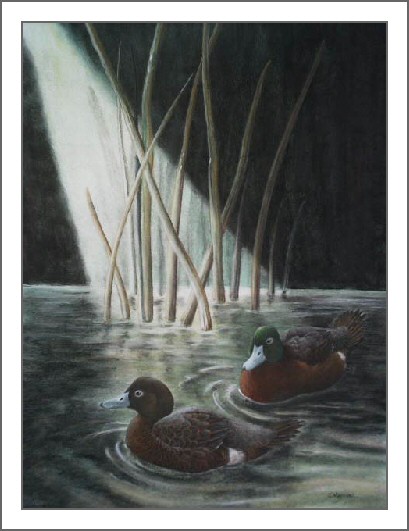

|
SCROLL DOWN TO FIND BIRDS THAT ARE ENDANGERED:
Some birds are rare than others, while some are not rare at all. But extremely rare, like the birds pictured here, means there's very few left in lifes pool. ORANGE-FRONTED PARAKEET; KOKAKO; STITCHBIRD; SADDLEBACK; BLACK ROBIN; KAKAPO; NOTORNIS; CHATHAM ISLAND SNIPE; NZ THRUSH; NZ BUSH WREN; KIWI; YELLOW- EYED PENGUIN ; CAMPBELL ISLAND BROWN TEAL
|
||||||||||
|---|---|---|---|---|---|---|---|---|---|---|
|
ORANGE-FRONTED PARAKEET Orange-fronted Parakeet Cyanoramphus malherbi FAMILY: Platycercidae Endemic and fully protected. Smallest of the NZ Parakeets, it is most similar to the Yellow-fronted Parakeet, but with an orange forhead and pale yellow crown. Previously found throughout the South Island in mountain forest areas, but now very rare, They are found in dense bush up to sub-alpine levels and sightings of Yellow-fronted Parakeets should be carefully checked for these rarer birds. They feed on fruits and seeds. Breeding is similar to the other parakeets.
KOKAKO / Blue-wattled Crow.
Kokako Callaeas cinerea FAMILY: Callaeidae Endemic, with 2 closely related sub-species shown in plate. Fully protected. Twice the size of a Tui with dark bluish-grey plumage. North Island has blue throat wattles while the South Island has blue wattles with orange base. The tail is long and drooping and the legs long and strong. It is not a good flier and has short, rounded wings. The Kokako is famed for its call, a wide orchestral range of bell and flute like notes that carry far into the bush. Once heard, never forgotten. They feed on fruits, leaves and flowers. The North Island species is rare but widely distributed in pockets of unmodified native bush throughout the North Island. The South Island species was formerly in forested areas of South and Stewart Islands but is now extremely rare, if not extinct. Breeding is from November to March. The nest is a platform of twigs and branches lined with mosses and fern scales, in a tree fork or tight branches up to 10mts above ground. The eggs, 2-3, are a pale stony-grey with brown and purple blotches and spots.
STITCHBIRD / Hihi
Stitchbird Notiomystis cincta FAMILY: Meliphagidae Endemic to NZ and fully protected. One of 3 honey eaters found in NZ. Size of Bellbird, the male with black head and neck, white ear tuft and yellow shoulder-patch. The female and immature birds are drab olive all over, with a white shoulder-patch which distinguishes it from the female Bellbird. The call is 'tzit'. These birds were originally in the southern North Island and major offshore islands, but is now confined to Little Barrier Island since the 1880s. Found in forest of varying types and attracted to nectar-bearing trees and shrubs, they feed on nectar of pohutukawa, kohekohe and flax, also insects. Breeding is from November to December and the nest of sticks, roots and tree fern scales is in holes of trees or branches. The eggs, 3-5, are white.
SADDLEBACK / Tieke
Saddleback Philesturnus carunculatus FAMILY: Callaedae Endemic with 2 closely related sub-species shown in plate. Fully protected. The size of a Tui, with orange wattles, red when breeding. One of 3 NZ wattle birds, the others being the Kokako and Stitchbird. The North Island species has a pale stripe seperating the black neck from the chestnut back. Does short flights and tends to hop from branch to branch. The North Island species was formerly abundant on the mainland and major offshore islands, but is now restricted naturally to Hen Island. Liberations on Cuvier, Fanal, Red Mercury and Middle Chicken Islands have proved successful. The South Island species was abundant on the mainland and major off-lying islands, becoming extinct on Big South Cape, Solomon and Pukaweka Islands by 1974. Subsequent liberations have been to Kaimohu and Stage Islands, with more liberations made to 4 other islands from those stocks. Saddleback feed on the forest floor or low tree trunks for invertabrates and fruits. Breeding is from October to January. The nest is of twigs with a fine lining, set in hollow trees or in dense cover from the ground to 2mt. The eggs, 2, are pale grey or white with light brown spots and blotches concentrated at the thick end. BLACK ROBIN
Black Robin Petroica traversi FAMILY: Muscicapidae Endemic and fully protected. Size between the Robin and Tomtit, all black. These birds were formally on Pitt and Mangere Islands of the Chatham Group, but are now confined to the small and precipitous Little Mangere Island. They are extremely rare and efforts have been made over the last 30 years or so to breed them by using Tomtits as foster parents. This mathos has proves successful and the numbers have risen. They inhabit low coastal Akeake forest and feed on a large range of insects and grubs. Breeding is from October to November. Nests are variable, usually a small cup with a lining including feathers and sheltered by a covering branch, or in a hollow branch or log. The eggs,2, are cream.
KAKAPO
Kakapo Strigops habroptilus FAMILY:Cacatuidae Endemic and fully protected. This is a very large ground parrot, nocturnal and flightless. The voice is a deep, hoarse booming, but the range of calls include a variety of eerie coughs, squeals and grunts. The are extremely rare and presently confined to a few valleys in Fiordland and Stewart Island, where birds were discovered late last century. Stocks have been transferred to a vermin-free island in the Marlborough Sounds. Found in forested areas up to the snow-line. They feed on a variety of grasses, berries and leaves. Breeding is from December to May and the nest is in hollow tree roots, under logs, in crevises or a deep excavated burrow. The eggs, 3, are white. Possibly only the female incubates and rears the chicks. NOTORNIS / Takahe
Notornis Notornis manteili FAMILY: Rallidae Endemic and fully protected. This is the largest of the living rails, with a massive red bill and short heavy legs. Flightless and ponderous. These birds were thought to be extinct until rediscovered in Fiordland in 1948. Confined to high, alpine, tussock grass lands valleys of Fiordland. Entry into the reserved areas is by permit only. There are continuing efforts to breed these birds at Mt Bruce Reserve, Wairarapa. They feed on grass, seeds, tussock and insects. Breeding is from October to November and the nest is a large bulky structure between clumps of tussock. The eggs, 1-2, are dull cream with brown and mauve blotches.
CHATHAM ISLAND SNIPE Chatham Island Snipe Coenocorypha aucklandica FAMILY: Scolopacidae Endemic with four other sub-species confined to southern offshore islands. Fully protected. New birds discovered on Chatham Island in 2005. These birds are about the size of a Song Thrush, with a long bill and fast, whirring flight, low and in short bursts. They are active at night and feed on worms and grubs on the forest floor and among grasses. Breeding is from November to December. The nest is a small depression on the ground, lined with grass and under cover of boulders or grass. The eggs, 2-3, are light brown, with brown spots and blotches all over.
NZ THRUSH
New Zealand Thrush/Piopio Turnagra capensis FAMILY: Turnagridae Endemic to NZ with two closely related sub-species. Fully protected. Both of these are presumed extinct, however there have been sighting claims in the forests of the South Island, although none have been substantiated. North and South Island are illustrated. They feed mainly on the ground on insects, vegetable matter, seeds and fruits. Breeding is in December and the nest is compact, made of twigs and moss-lined with grasses and fern scales. They build the nest up to 4mts from the ground. The eggs, 2, are white with black or brown spots, concentrated on the larger end.
BUSH WREN
South Island Bush Wren Xenicus longipes FAMILY: Xenecidae Endemic with two other sub-species. Fully protected. Larger and darker in colour than the Rifleman with a conspicuous eye stripe and bobbing of the body after landing. The voice is a subdued trill. Little is known of this bird and it is extrmely rare. It was formally widespread in remote forested mountain areas of the Tasman and Spencer Ranges, Westland and Otago, There have been reports of them in Fiordland and the Nelson Lakes area. The feed among foliage on insects. Breeding is from November to December and the nest is pouch-shaped, of closely woven rootlets, lined with feathers on or close to the ground. The eggs, 2-3, are white. The North Island Bush Wren is presumed extinct, while Steads Bush Wren, which was previously on Stewart Island, is close to extinction on islands off the SW coast of Stewart Island.
KIWI
Brown Kiwi Apteryx australis FAMILY: Apterygidae Endemic Little Spotted Kiwi Apteryx oweni FAMILY: Apterygidae Great Spotted Kiwi Apteryx Haasti FAMILY: Apterigidae All three sub-species are now considered endangered. Read about them in Aviary 1, Bush Birds.
YELLOW-EYED PENGUIN / Hoiho
Yellow-eyed Penguin Megadyptes antipodes FAMILY: Spheniscidae Endemic and fully protected. This is the largest of the New Zealand mainland penguins. The adult has a yellow eye and yellow band all round the head. The immature have a grey eye and no yellow band. Found on the eastern coast of the South Island of New Zealand, and on the sub-Antarctic Islands of Auckland and Campbell. The yellow-eyed penguin is one of the world’s rarest penguins. They nest hidden from each other. Breeding is from September to February, and their nest of sticks and coarse grasses are usually found in scrubland and coastal bush, sometimes up to a kilometer inland. The eggs, 2, are white.
CAMPBELL ISLAND FLIGHTLESS BROWN TEAL
Campbell Island Flightless Brown Teal Anus aucklandica nesiotis Fully protected. Endemic and critically endangered. These little ducks were thought to inhabit the Campbell Island group. Now, through predation, there are less than 20 birds surviving on a tiny remote 'rock' called Dent Island in the sub-antarctic. This is a small, dark brown duck and a sub-species of the Brown Teal. They are flightless and nocturnal. They are found in pairs or small flocks and the call is a series of whistle-like notes that form a trill. They run rapidly along the ground and feed on invertabrates and some plants. There are about 60 birds at present in the wild (mid 2006) and there is a captive breeding programme with captive bred birds being released on Campbell Island in 2006. |

Copyright(c) 2006 Janet Marshall. All rights reserved.
myid@myhost.com
nbsp;
nbsp;















